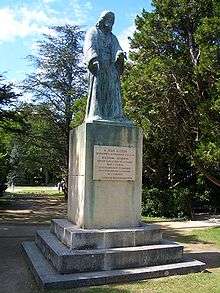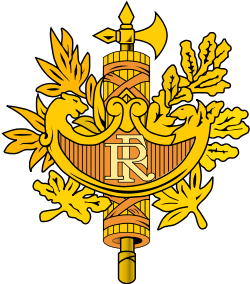Armenia–France relations
 |
|
France |
Armenia |
|---|---|
Franco-Armenian relations have existed since the French and the Armenians established contact in the Armenian Kingdom of Cilicia In the 1100s. Formal diplomatic relations between Armenia and France were established on 24 February 1992 and are regarded as excellent, with both countries cooperating on the aspects of diplomacy, culture and military. In effect of the excellent relations between the two countries 2006 was proclaimed the Year of Armenia in France.[1]
History
During the Middle Ages

Prior to the 11th century, the Franks and the Armenians didn't have much contact together, because of the distance separating them. However, there were earlier contacts between Armenians and Franks by way of the Roman Empire. In 554 during the Battle of Casilinum the Armenian general Narses of the Eastern Roman Empire drove out the Franks and their allies the Alemanni from the Italian peninsula.
Towards the 11th century, the Armenians established the Principality and then Kingdom of Cilicia, which was located on the Mediterranean coast and thus accessible to the Franks and other Europeans who were participating in the Crusades. Armenia was the last Christian safe haven for the Crusaders before facing the Islamic armies of Syria and Palestine. Unlike the Turkic arrival into the area, the Frankish arrival was interpreted positively by Armenian writers and other intellectuals.
In the twelfth and thirteenth centuries, continuous contact with Western Europe, most notably with the Frankish Kingdom made way for major social, cultural, and political change in Cilician Armenia. Armenians, who have their own branch of Christianity, came in contact with (and were influenced by) Catholic ideals.
The last dynasty (the Lusignans) to rule Cilician Armenia was of Frankish origin. The last king, Leo VI of Armenia, was buried in Saint Denis Basilica alongside notable French kings such as Charles Martel, Louis XIV, and many others. He was in fact the only foreigner who was buried there.
Contact within the Ottoman Empire

During the reign of Louis XIV, a large number of Armenian manuscripts were taken into the National Library of France. Armenia and Armenian characters are often featured in classical French literature. Authors such as Montesquieu, Voltaire, Rousseau, and many others often talked about the contact of their main characters with Armenian secondary characters.
Armenian studies would start to develop in France after the creation of the Armenian department of the School of Oriental languages with the initiative of Napoleon I.
Modern diplomatic relations

Diplomatic relations between the Republic of Armenia and the French Republic were established on 24 February 1992. On 2 October 2009, Vigen Chitechian was appointed Ambassador Extraordinary and Plenipotentiary of the Republic of Armenia to France.[2] On 5 November 2010, Henri Reynaud, Ambassador Extraordinary and Plenipotentiary of the French Republic to Armenia, presented his credentials to the President of the Republic of Armenia, Serzh Sargsyan. Also on 1 December 2011 Vardan Sirmakes was appointed Consul General of the Republic of Armenia in Marseille.[3]
On January 7, 2015, Minister of Foreign Affairs of Armenia Eduard Nalbandyan issued a press release on the Charlie Hebdo shooting, saying, "We strongly condemn terrorist act committed at the office of 'Charlie Hebdo' magazine in Paris" and added that "such appalling actions of extremists has no justification whatsoever and once again prove the necessity of wider solidarity in the international community's fight against terrorism." The Armenian Government also expressed their "condolences and support to the people, authorities of friendly France, editorial staff of 'Charlie Hebdo' magazine, and the relatives of the victims."[4]
Armenian Genocide
Towards the beginning of the 20th century, the pro-Armenian French would start to defend the Armenians’ rights whenever they were least respected. During 1915, the French welcomed tens of thousands of Armenians into their country which was a safe haven for them. France was also one of the few countries to send rescue boats for the Armenians. After a heroic 53-day battle of self-defence, the population of Musa Dagh was rescued by the French. The population would eventually settle in Lebanon, mainly in the town of Anjar.
In 1998, a resolution by the French National Assembly, saying “France recognizes the Armenian genocide of 1915." was passed which came with strong Turkish objection.[5]
France was also the first European country to officially recognize the Armenian Genocide (2001). Jacques Chirac
In 2006, tensions mounted between France and Turkey after the French National Assembly voted in favor of a bill which makes Armenian Genocide denial illegal.
Armenians in France
The Armenians of France, now numbering between 250,000[6] and 750,000,[7] remained close to their cultural origins, while at the same time; they integrated in France and contributed greatly to Francophone culture.
Many Armenian writers, painters and musicians, such as Sarian, Kochar, Issahakian, Komitas, and many others have worked and have died in France. Both French and Armenians are proud of the likes of Charles Aznavour and Henri Verneuil.
See also
Notes and references
- ↑ http://www.diplomatie.gouv.fr/en/country-files/armenia-366/
- ↑ http://www.mfa.am/en/by-countries/fr/
- ↑ http://www.mediamax.am/en/news/politics/3330/
- ↑ Edward Nalbandian. “Strongly condemn terrorist act committed in Paris”, Ministry of Foreign Affairs of the Republic of Armenia, 7 January 2015
- ↑ Jones, Adam (2010). Genocide: A Comprehensive Introduction. p. 170.
- ↑ Thon, Caroline (2012). Armenians in Hamburg: an ethnographic exploration into the relationship between diaspora and success. Berlin: LIT Verlag Münster. p. 25. ISBN 978-3-643-90226-9.
- ↑ Taylor, Tony (2008). Denial: history betrayed. Carlton, Victoria: Melbourne University Publishing. p. 4. ISBN 978-0-522-85482-4.

